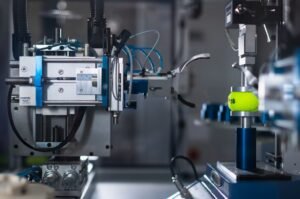What’s Machine Learning Used For?
Machine learning is a branch of artificial intelligence that focuses on the development of computer algorithms capable of analyzing and learning from data to make predictions or decisions. It has become an increasingly popular field with widespread applications in various industries.
Key Takeaways
- Machine learning is a subset of artificial intelligence that uses algorithms to analyze data and make predictions.
- It has applications in industries such as healthcare, finance, marketing, and transportation.
- The three main types of machine learning are supervised learning, unsupervised learning, and reinforcement learning.
**Machine learning** can be employed in a wide range of industries due to its ability to analyze large amounts of data and uncover patterns or insights that might not be easily noticeable by humans. This article explores some of the common applications of machine learning and its impact on various sectors.
In healthcare, machine learning is used for tasks such as diagnosing diseases, predicting patient outcomes, and drug discovery. It allows medical professionals to make more accurate diagnoses and develop personalized treatment plans.
1. Healthcare
Machine learning has revolutionized the healthcare industry by enabling the analysis of vast amounts of medical data. Some notable applications include:
- Diagnosis: Machine learning algorithms can analyze patient data such as symptoms, medical history, and test results to assist in diagnosing diseases.
- Patient Outcomes: Predictive models can be developed using machine learning to forecast patient outcomes and identify risk factors.
- Drug Discovery: Machine learning algorithms can analyze genetic data and molecular structures to aid in the discovery and development of new drugs.
In finance, machine learning plays a crucial role in tasks such as fraud detection, stock market prediction, and credit scoring. It helps financial institutions make informed decisions and improve customer experience.
2. Finance
Machine learning algorithms have transformed the finance industry by automating processes and enabling data-driven decision-making. Some notable applications include:
| Application | Description |
|---|---|
| Fraud Detection | Machine learning algorithms can analyze patterns in transactions data to detect fraudulent activities. |
| Stock Market Prediction | Using historical data and market indicators, machine learning models can forecast stock prices. |
| Credit Scoring | Machine learning can analyze credit-related data to assess the creditworthiness of individuals or businesses. |
**Marketing** heavily relies on machine learning for customer segmentation, recommendation systems, and targeted advertising. It allows businesses to deliver personalized marketing strategies and improve customer satisfaction.
3. Marketing
Machine learning has revolutionized the marketing industry by leveraging data to make informed decisions and improve advertising strategies. Some common applications include:
- Customer Segmentation: Machine learning algorithms can analyze customer data to identify distinct segments and tailor marketing campaigns accordingly.
- Recommendation Systems: E-commerce platforms often use machine learning algorithms to suggest products based on user preferences and purchase history.
- Targeted Advertising: Machine learning can analyze customer profiles and behavior to deliver personalized ads that resonate with individual customers.
**Transportation** is another industry where machine learning shines, with applications such as autonomous vehicles, traffic prediction, and route optimization, aiming to enhance safety and efficiency.
4. Transportation
Machine learning plays a significant role in transforming transportation systems through advanced analytics and automation. Some notable applications include:
- Autonomous Vehicles: Machine learning algorithms enable self-driving cars to interpret and respond to their environment.
- Traffic Prediction: By analyzing historical and real-time traffic data, machine learning models can accurately predict congestion patterns and optimize traffic flow.
- Route Optimization: Machine learning algorithms can optimize delivery routes for logistics companies, reducing fuel consumption and enhancing efficiency.
Conclusion
Machine learning has become an integral part of various industries, ranging from healthcare and finance to marketing and transportation. Its ability to analyze large amounts of data and make accurate predictions has transformed decision-making processes and improved overall efficiency.

Common Misconceptions
Misconception 1: Machine Learning is only used in high-tech industries
One common misconception about machine learning is that it is solely limited to high-tech industries such as software development and data analytics. However, this is not true as machine learning is being applied across various sectors and industries.
- Machine learning is used in healthcare to help with diagnostics and personalized patient care
- It is used in finance to detect fraudulent activities and make predictions in the stock market
- Retail industry leverages machine learning for customer preference analysis and targeted marketing campaigns
Misconception 2: Machine Learning can replace human intelligence completely
Another misconception is that machine learning can completely replace human intelligence and decision-making. Although machine learning algorithms can process and analyze large amounts of data much faster than humans, they still require human involvement for context and interpretation.
- Human expertise is crucial for training machine learning models and providing the necessary domain knowledge
- Machines may lack the ability for ethical decision-making and empathy, which are essential in certain contexts
- Human oversight is required to ensure transparency, accountability, and fairness in machine learning applications
Misconception 3: Machine Learning always provides accurate results
Some people mistakenly believe that machine learning always delivers accurate results. However, this is not the case as the accuracy of machine learning models depends on several factors such as data quality, model complexity, and the appropriateness of algorithms used.
- Poor quality or biased training data can lead to biased or inaccurate predictions
- Complex models can easily overfit the training data, resulting in poor generalization to new examples
- The choice of an inappropriate algorithm for a specific task can yield unreliable results
Misconception 4: Machine Learning is a magical solution that can solve any problem
There is a misconception that machine learning is a one-size-fits-all solution that can solve any problem. While machine learning is incredibly powerful, it has its limitations and cannot solve every problem or provide answers to every question.
- Machine learning requires large amounts of quality data to train models effectively
- Some problems may have inherent complexities that are difficult to capture with machine learning algorithms
- Not all problems can be formulated as machine learning tasks or have enough labeled data available
Misconception 5: Machine Learning will lead to widespread unemployment
One common fear surrounding machine learning is that it will lead to widespread unemployment as it may replace human jobs. However, the reality is that machine learning is more likely to transform jobs rather than eliminate them.
- Machine learning can automate repetitive tasks, allowing humans to focus on more complex and creative work
- New roles will emerge that require expertise in developing and maintaining machine learning systems
- Machine learning can augment human decision-making, leading to improved productivity and efficiency

What’s Machine Learning Used For?
Introduction
Machine learning is a field of study that focuses on the development of algorithms and models that allow computers to learn and make decisions without being explicitly programmed. It has applications in various industries and is used for a wide range of purposes. This article explores ten interesting examples of how machine learning is utilized in different domains.
1. Predicting Weather
Machine learning algorithms are used in weather forecasting models to predict temperature, rainfall, and other meteorological parameters accurately. These algorithms analyze historical weather data, satellite images, and atmospheric conditions to make accurate forecasts for different regions.
2. Recommendation Systems
Online platforms like Netflix and Amazon utilize machine learning to provide personalized recommendations to their users. These systems analyze users’ past behavior, preferences, and similar profiles to suggest movies, products, and other relevant content.
3. Medical Diagnosis
Machine learning algorithms assist doctors in diagnosing diseases and recommending appropriate treatments. These algorithms analyze patient data, medical images, and electronic health records to identify patterns and make predictions, aiding in early detection and improving patient outcomes.
4. Fraud Detection
Financial institutions employ machine learning algorithms to detect fraudulent activities such as credit card fraud. These algorithms analyze transaction patterns, customer behavior, and other variables to identify suspicious activities and prevent fraudulent transactions.
5. Autonomous Vehicles
Machine learning plays a crucial role in the development of self-driving cars. These vehicles use sensors and cameras to collect data about their surroundings, and machine learning algorithms process this data to make real-time decisions, ensuring safe and efficient navigation.
6. Natural Language Processing
Machine learning algorithms are used in natural language processing applications like speech recognition and language translation. These algorithms analyze language patterns, audio data, and linguistic rules to understand and generate human-like text or speech.
7. Financial Trading
Machine learning is extensively used in algorithmic trading, where computers automatically execute trades based on market data and historical trends. These algorithms analyze vast amounts of data and identify patterns that help in making profitable trading decisions.
8. Image and Video Recognition
Machine learning algorithms can recognize objects, faces, and scenes in images and videos with impressive accuracy. This technology has applications in surveillance, image searching, autonomous drones, and other visual processing tasks.
9. Drug Discovery
Machine learning is used in pharmaceutical research to analyze large datasets, predict drug interactions, and identify potential drug candidates. These algorithms help accelerate the drug discovery process, potentially leading to the development of life-saving medications.
10. Energy Management
Machine learning algorithms are employed in optimizing energy usage and managing power grids more efficiently. These algorithms analyze historical energy consumption data, weather patterns, and other factors to make predictions and optimize power generation and distribution.
Conclusion
Machine learning has revolutionized numerous industries and enabled the development of innovative solutions in areas such as weather forecasting, recommendation systems, medical diagnosis, fraud detection, autonomous vehicles, natural language processing, financial trading, image and video recognition, drug discovery, and energy management. By leveraging the power of data and algorithms, machine learning continues to drive technological advancements and improve the overall quality of our lives.
Frequently Asked Questions
What is machine learning?
Machine learning is a subset of artificial intelligence that focuses on the development of algorithms and statistical models to enable computer systems to automatically learn and improve from experience without being explicitly programmed.
How does machine learning work?
Machine learning involves the creation of models that can learn patterns and make predictions or decisions based on input data. These models are trained on a dataset and use different algorithms and techniques to identify patterns, relationships, and trends in the data, which are then used to make predictions or decisions on new or unseen data.
What are the applications of machine learning?
Machine learning has a wide range of applications across various industries. It is used in image and speech recognition, natural language processing, recommendation systems, fraud detection, predictive maintenance, autonomous vehicles, healthcare, finance, and many other fields.
Can machine learning algorithms work with any type of data?
Machine learning algorithms can work with a variety of data types, including numerical, categorical, text, and image data. However, different algorithms may be better suited for different types of data, so the choice of algorithm depends on the nature of the data and the specific problem being addressed.
What is supervised learning?
Supervised learning is a type of machine learning where the algorithm learns from labeled examples. It is provided with a dataset containing input features and corresponding labels, and it learns a function that maps the input features to the labels. The trained model can then be used to make predictions on new or unseen data.
What is unsupervised learning?
Unsupervised learning is a type of machine learning where the algorithm learns from unlabeled data. It attempts to uncover hidden patterns or structures in the data without any predefined labels. Common unsupervised learning techniques include clustering, dimensionality reduction, and anomaly detection.
What is the difference between machine learning and deep learning?
Deep learning is a subfield of machine learning that focuses on using artificial neural networks with multiple layers to learn complex patterns and representations. While both machine learning and deep learning involve training models on data, deep learning algorithms are specifically designed to handle large amounts of data and can automatically learn hierarchical representations of the data.
Can machine learning be used for real-time decision-making?
Yes, machine learning can be used for real-time decision-making. There are techniques and algorithms that allow models to make predictions or decisions in real-time based on streaming data. These real-time machine learning systems are often used in applications such as fraud detection, recommendation systems, and autonomous vehicles.
What are the challenges in implementing machine learning?
Implementing machine learning can be challenging due to various factors. Some challenges include the need for large and diverse datasets, the selection of appropriate algorithms and models, handling missing or noisy data, ensuring model interpretability and fairness, and addressing ethical considerations related to privacy and bias.
How can machine learning benefit businesses and society?
Machine learning can benefit businesses and society in many ways. It can help businesses improve efficiency, make better decisions, personalize customer experiences, and identify patterns and trends for competitive advantage. In society, machine learning can be used for healthcare diagnostics, energy efficiency, environmental monitoring, traffic management, and various other applications that can enhance human well-being and address societal challenges.




